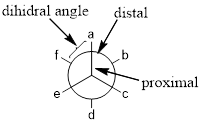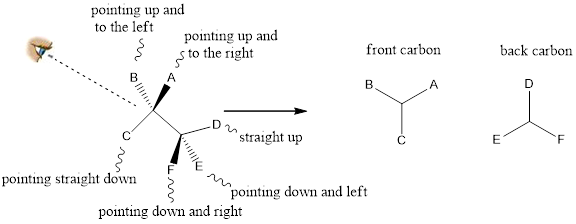
Concept explainers
(a)
Interpretation:
A Newman projection of the allene when viewed from the left side of its
Concept Introduction:
Allenes are compounds with two or more double bonds side-by side. Such bonds are called cumulated double bonds.

Allenes shows axial chirality. Axial chirality is a stereoisomerism resulting from the non-planar arrangemen6t of four groups in pairs about a chiral axis.
Newman projection: Newman projection of molecule is one type of representations for the

From the angle of observer the front carbon is proximal and second carbon is distal.
In wedge-dash line representation, wedge is coming out of the plane and going behind the plane, the wedge and the dash of front carbon in Newman projection are pointing up and the wedge and the dash of back carbon in Newman projection are pointing down.

(b)
Interpretation:
Enantiomer of the given compound has to be drawn in bond-line format and as a Newman projection.
Concept Introduction:
Allenes are compounds with two or more double bonds side-by side. Such bonds are called cumulated double bonds.

Allenes shows axial chirality. Axial chirality is a stereoisomerism resulting from the non-planar arrangemen6t of four groups in pairs about a chiral axis.
Newman projection: Newman projection of molecule is one type of representations for the alkanes, where the projection visualization from one carbon to another carbon. In this Newman projection, front carbon which represented as dot is called proximal and the back carbon which represented as circle is called distal.

From the angle of observer the front carbon is proximal and second carbon is distal.
In wedge-dash line representation wedge is coming out of the plane and going behind the plane, the wedge and the dash of front carbon in Newman projection are pointing up and the wedge and the dash of back carbon in Newman projection are pointing down.

Enantiomers: These are stereoisomers that are not superimposable mirror images of each other and the configurations at all stereo genic centers are exactly opposite.
(c)
Interpretation:
Two diastereomers of the given compound has to be drawn in bond-line format and as a Newman projection.
Concept Introduction:
Allenes are compounds with two or more double bonds side-by side. Such bonds are called cumulated double bonds.

Allenes shows axial chirality. Axial chirality is a stereoisomerism resulting from the non-planar arrangemen6t of four groups in pairs about a chiral axis.
Newman projection: Newman projection of molecule is one type of representations for the alkanes, where the projection visualization from one carbon to another carbon. In this Newman projection, front carbon which represented as dot is called proximal and the back carbon which represented as circle is called distal.

From the angle of observer the front carbon is proximal and second carbon is distal.
In wedge-dash line representation wedge is coming out of the plane and going behind the plane, the wedge and the dash of front carbon in Newman projection are pointing up and the wedge and the dash of back carbon in Newman projection are pointing down.

Enantiomers: These are stereoisomers that are not superimposable mirror images of each other and the configurations at all stereo genic centers are exactly opposite.
Diastereomers: These are stereoisomers that are not enantiomers of one another. They have different physical properties so that they are viewed as different chemical substances.
Trending nowThis is a popular solution!

Chapter 5 Solutions
Organic Chemistry, 3e WileyPLUS Registration Card + Loose-leaf Print Companion
- Nonearrow_forward4. Draw and label all possible isomers for [M(py)3(DMSO)2(CI)] (py = pyridine, DMSO dimethylsulfoxide).arrow_forwardThe emission data in cps displayed in Table 1 is reported to two decimal places by the chemist. However, the instrument output is shown in Table 2. Table 2. Iron emission from ICP-AES Sample Blank Standard Emission, cps 579.503252562 9308340.13122 Unknown Sample 343.232365741 Did the chemist make the correct choice in how they choose to display the data up in Table 1? Choose the best explanation from the choices below. No. Since the instrument calculates 12 digits for all values, they should all be kept and not truncated. Doing so would eliminate significant information. No. Since the instrument calculates 5 decimal places for the standard, all of the values should be limited to the same number. The other decimal places are not significant for the blank and unknown sample. Yes. The way Saman made the standards was limited by the 250-mL volumetric flask. This glassware can report values to 2 decimal places, and this establishes our number of significant figures. Yes. Instrumental data…arrow_forward
- 7. Draw a curved arrow mechanism for the following reaction. HO cat. HCI OH in dioxane with 4A molecular sievesarrow_forwardTry: Convert the given 3D perspective structure to Newman projection about C2 - C3 bond (C2 carbon in the front). Also, show Newman projection of other possible staggered conformers and circle the most stable conformation. Use the template shown. F H3C Br Harrow_forwardNonearrow_forward
 ChemistryChemistryISBN:9781305957404Author:Steven S. Zumdahl, Susan A. Zumdahl, Donald J. DeCostePublisher:Cengage Learning
ChemistryChemistryISBN:9781305957404Author:Steven S. Zumdahl, Susan A. Zumdahl, Donald J. DeCostePublisher:Cengage Learning ChemistryChemistryISBN:9781259911156Author:Raymond Chang Dr., Jason Overby ProfessorPublisher:McGraw-Hill Education
ChemistryChemistryISBN:9781259911156Author:Raymond Chang Dr., Jason Overby ProfessorPublisher:McGraw-Hill Education Principles of Instrumental AnalysisChemistryISBN:9781305577213Author:Douglas A. Skoog, F. James Holler, Stanley R. CrouchPublisher:Cengage Learning
Principles of Instrumental AnalysisChemistryISBN:9781305577213Author:Douglas A. Skoog, F. James Holler, Stanley R. CrouchPublisher:Cengage Learning Organic ChemistryChemistryISBN:9780078021558Author:Janice Gorzynski Smith Dr.Publisher:McGraw-Hill Education
Organic ChemistryChemistryISBN:9780078021558Author:Janice Gorzynski Smith Dr.Publisher:McGraw-Hill Education Chemistry: Principles and ReactionsChemistryISBN:9781305079373Author:William L. Masterton, Cecile N. HurleyPublisher:Cengage Learning
Chemistry: Principles and ReactionsChemistryISBN:9781305079373Author:William L. Masterton, Cecile N. HurleyPublisher:Cengage Learning Elementary Principles of Chemical Processes, Bind...ChemistryISBN:9781118431221Author:Richard M. Felder, Ronald W. Rousseau, Lisa G. BullardPublisher:WILEY
Elementary Principles of Chemical Processes, Bind...ChemistryISBN:9781118431221Author:Richard M. Felder, Ronald W. Rousseau, Lisa G. BullardPublisher:WILEY





